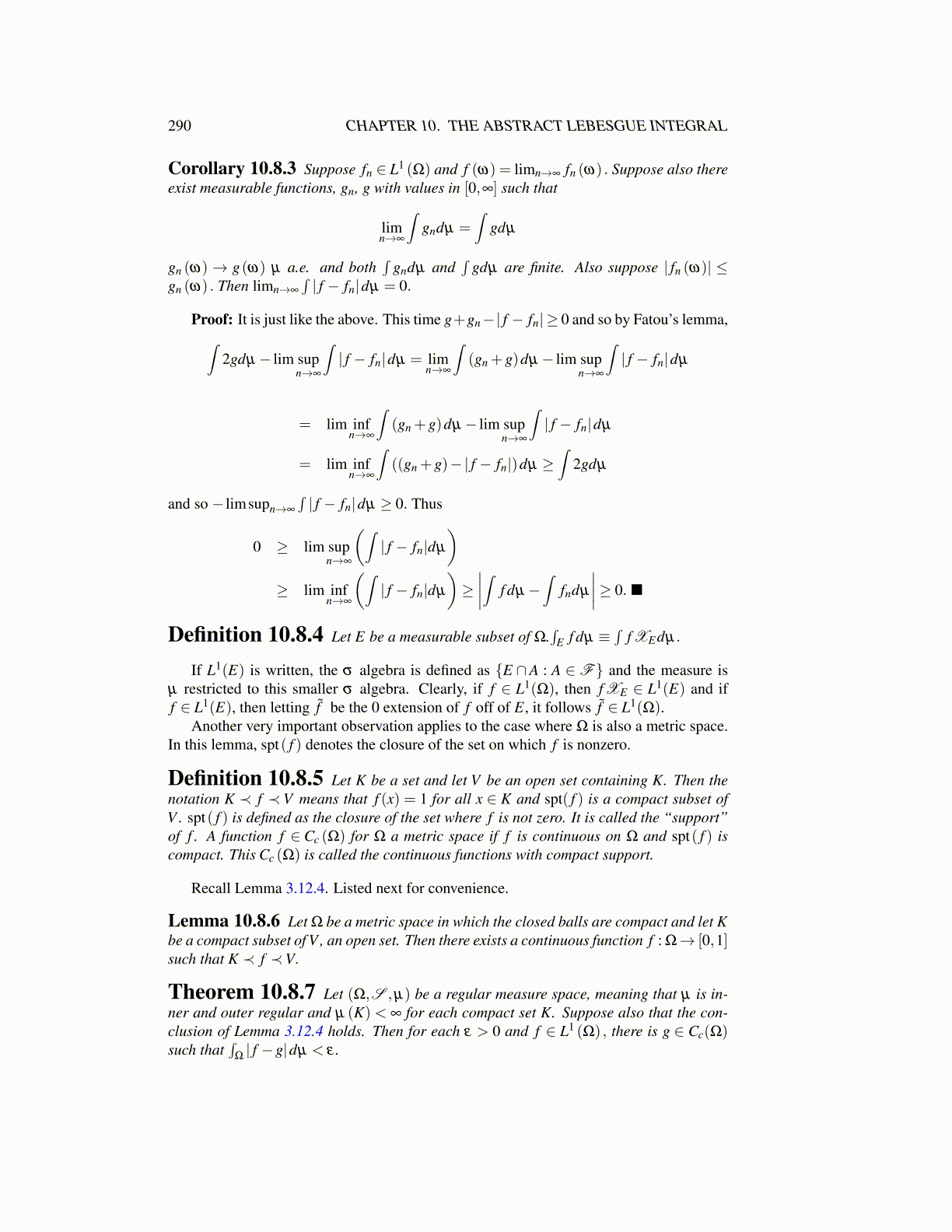
290 CHAPTER 10. THE ABSTRACT LEBESGUE INTEGRAL
Corollary 10.8.3 Suppose fn ∈ L1 (Ω) and f (ω) = limn→∞ fn (ω) . Suppose also thereexist measurable functions, gn, g with values in [0,∞] such that
limn→∞
∫gndµ =
∫gdµ
gn (ω)→ g(ω) µ a.e. and both∫
gndµ and∫
gdµ are finite. Also suppose | fn (ω)| ≤gn (ω) . Then limn→∞
∫| f − fn|dµ = 0.
Proof: It is just like the above. This time g+gn−| f − fn| ≥ 0 and so by Fatou’s lemma,∫2gdµ− lim sup
n→∞
∫| f − fn|dµ = lim
n→∞
∫(gn +g)dµ− lim sup
n→∞
∫| f − fn|dµ
= lim infn→∞
∫(gn +g)dµ− lim sup
n→∞
∫| f − fn|dµ
= lim infn→∞
∫((gn +g)−| f − fn|)dµ ≥
∫2gdµ
and so − limsupn→∞
∫| f − fn|dµ ≥ 0. Thus
0 ≥ lim supn→∞
(∫| f − fn|dµ
)≥ lim inf
n→∞
(∫| f − fn|dµ
)≥∣∣∣∣∫ f dµ−
∫fndµ
∣∣∣∣≥ 0. ■
Definition 10.8.4 Let E be a measurable subset of Ω.∫
E f dµ ≡∫
f XEdµ.
If L1(E) is written, the σ algebra is defined as {E ∩A : A ∈ F} and the measure isµ restricted to this smaller σ algebra. Clearly, if f ∈ L1(Ω), then f XE ∈ L1(E) and iff ∈ L1(E), then letting f̃ be the 0 extension of f off of E, it follows f̃ ∈ L1(Ω).
Another very important observation applies to the case where Ω is also a metric space.In this lemma, spt( f ) denotes the closure of the set on which f is nonzero.
Definition 10.8.5 Let K be a set and let V be an open set containing K. Then thenotation K ≺ f ≺ V means that f (x) = 1 for all x ∈ K and spt( f ) is a compact subset ofV . spt( f ) is defined as the closure of the set where f is not zero. It is called the “support”of f . A function f ∈ Cc (Ω) for Ω a metric space if f is continuous on Ω and spt( f ) iscompact. This Cc (Ω) is called the continuous functions with compact support.
Recall Lemma 3.12.4. Listed next for convenience.
Lemma 10.8.6 Let Ω be a metric space in which the closed balls are compact and let Kbe a compact subset of V , an open set. Then there exists a continuous function f : Ω→ [0,1]such that K ≺ f ≺V.
Theorem 10.8.7 Let (Ω,S ,µ) be a regular measure space, meaning that µ is in-ner and outer regular and µ (K) < ∞ for each compact set K. Suppose also that the con-clusion of Lemma 3.12.4 holds. Then for each ε > 0 and f ∈ L1 (Ω) , there is g ∈ Cc(Ω)such that
∫Ω| f −g|dµ < ε .